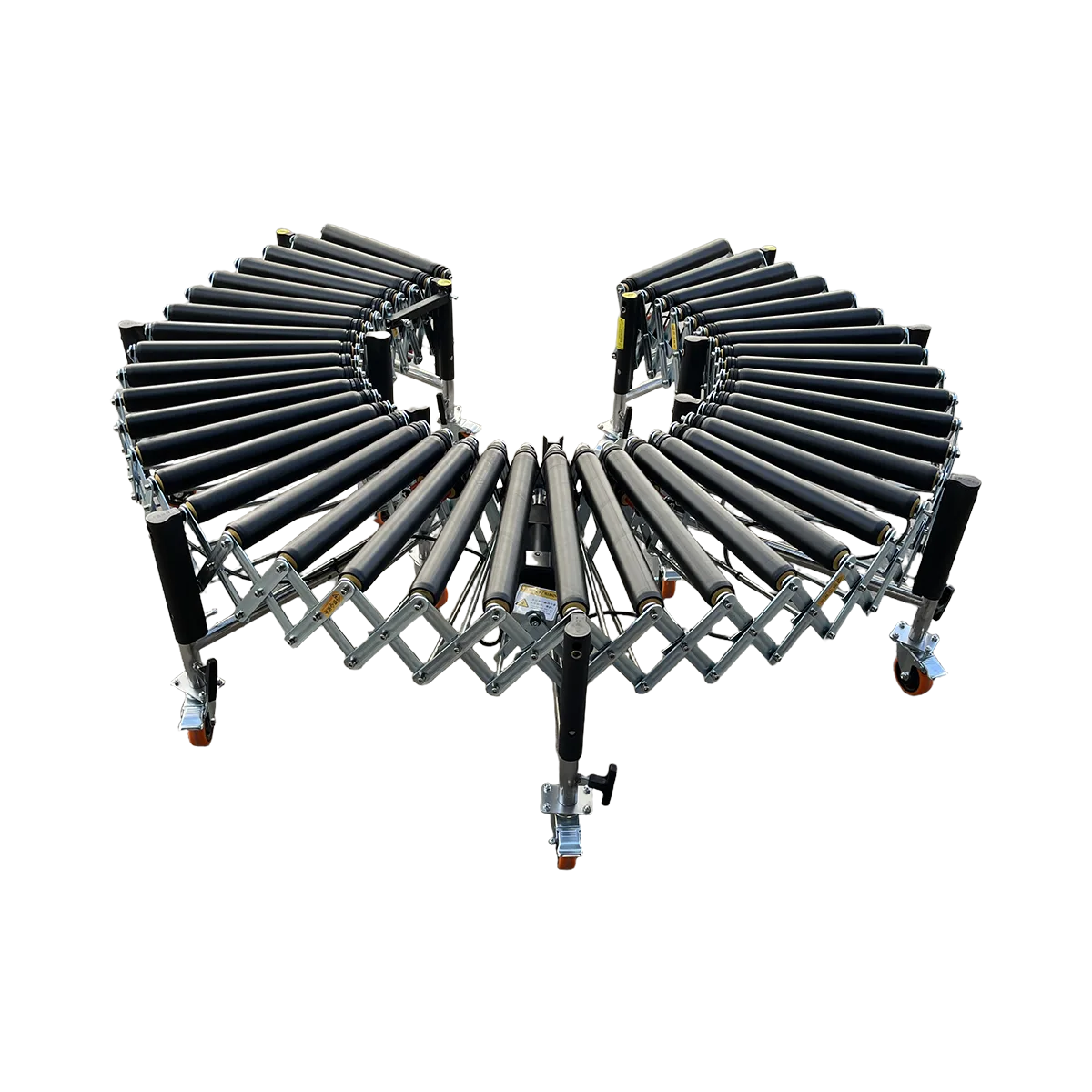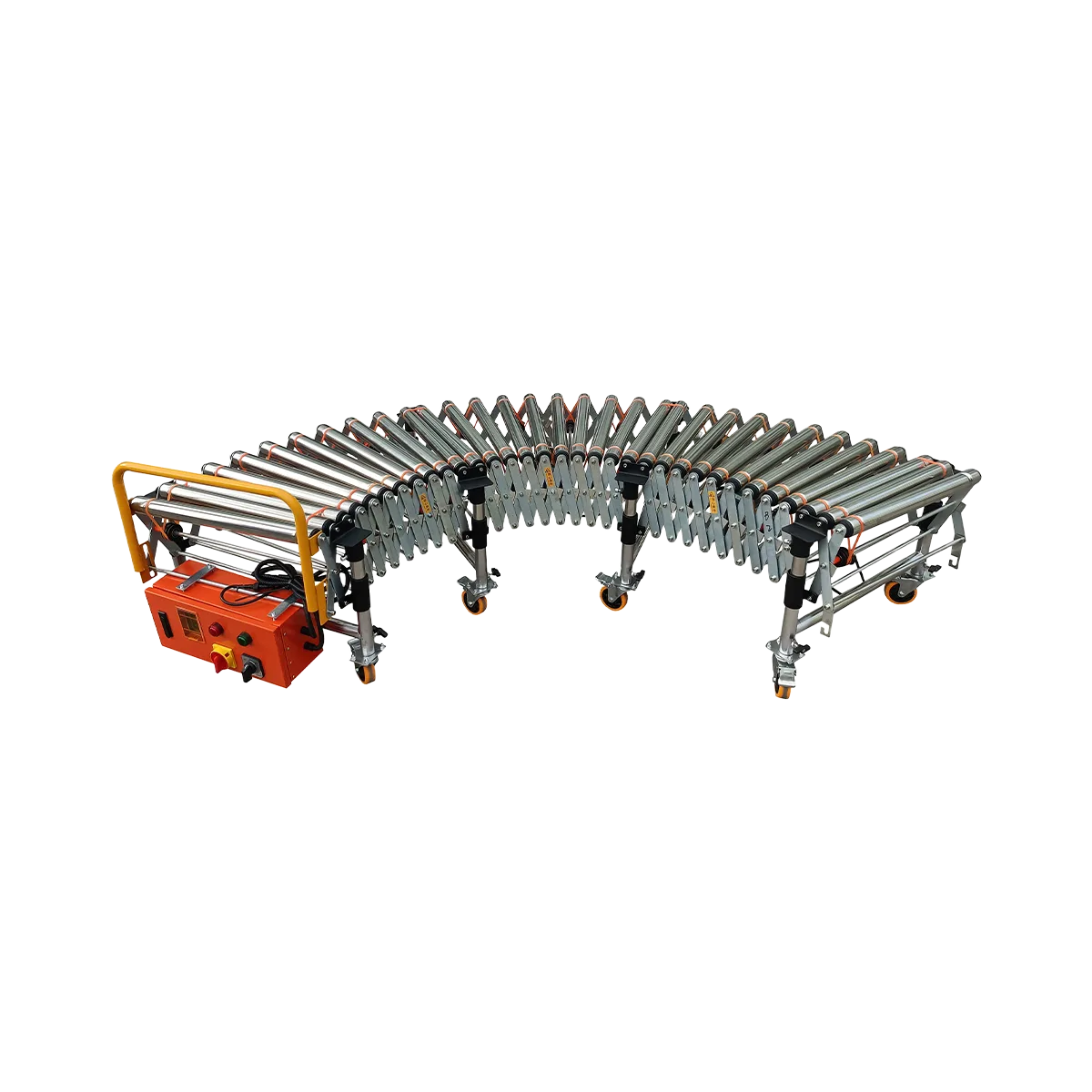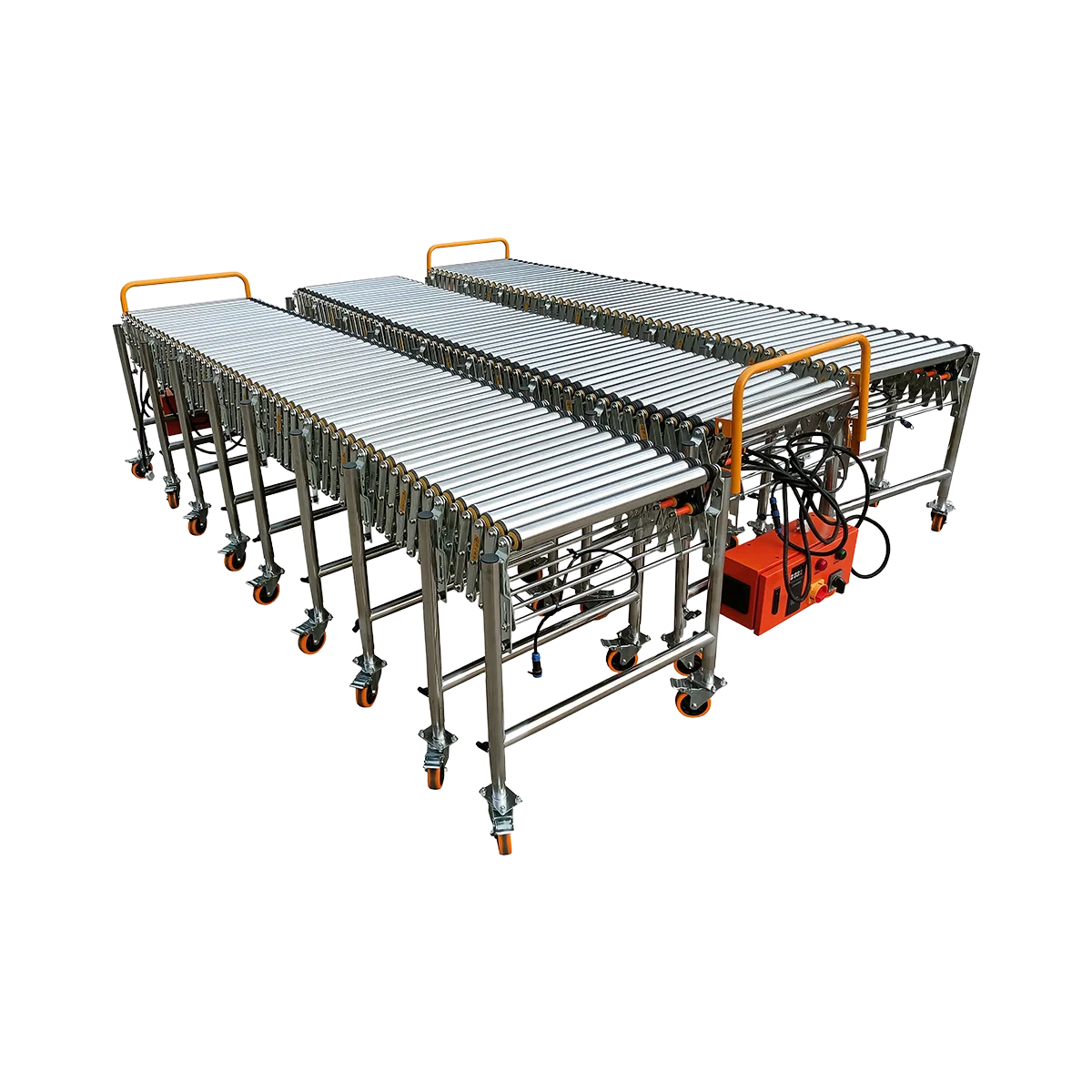Setting Up a Temporary Unloading Line for Seasonal Peaks
Discover how to implement a temporary conveyor system for seasonal warehouse demands that sets up in minutes, stores compactly, and scales your logistics operations efficiently.
Related Products
- Powered Rubber Roller Conveyor – Multi-wedge Belt Driven – 1100 mm/SectionCollapsed Length
560 mm
Extended Length1100 mm
Load Capacity120 kg/m
Applicable GoodsFlat-bottomed Goods
Bagged Goods
- Powered Roller Conveyor – O-shaped Belt Driven – 1500 mm/SectionCollapsed Length
525 mm
Extended Length1500 mm
Load Capacity80 kg/m
Applicable GoodsFlat-bottomed Goods
- Powered Roller Conveyor – Multi-wedge Belt Driven – 2000 mm/SectionCollapsed Length
700 mm
Extended Length2000 mm
Load Capacity100 kg/m
Applicable GoodsFlat-bottomed Goods
- Powered Roller Conveyor – Multi-wedge Belt Driven – 3000 mm/SectionCollapsed Length
1050 mm
Extended Length3000 mm
Load Capacity80 kg/m
Applicable GoodsFlat-bottomed Goods
Seasonal peaks present a unique challenge for logistics operations. Whether it’s holiday retail rushes, agricultural harvest seasons, or promotional events, many businesses experience dramatic volume fluctuations throughout the year. When your throughput triples for just 6-8 weeks annually, investing in permanent, fixed conveyor infrastructure becomes difficult to justify financially. The ideal temporary conveyor system needs to deploy quickly when demand spikes, perform reliably during intense usage periods, and then store efficiently until the next peak season.
Traditional approaches often force businesses into suboptimal choices: either overinvest in permanent systems that sit idle most of the year, or struggle through peak periods with inadequate manual handling methods that increase labor costs and injury risks. However, modern modular conveyor technology offers a third option—flexible, reconfigurable systems that can be rapidly deployed for seasonal peaks and then compactly stored during standard operations. This approach allows operations to scale their material handling capacity precisely when needed, without committing valuable floor space and capital to permanent installations.
The Smart Alternative: A ‘Conveyor-in-a-Box’ approach with Naili’s flexible systems
The “Conveyor-in-a-Box” concept represents a paradigm shift in how businesses approach seasonal warehouse solutions. Rather than viewing conveyor systems as permanent infrastructure, this approach treats them as flexible tools that can be deployed, reconfigured, and stored as operational needs change.
Key Advantages of the Flexible Approach:
- Capital efficiency: Invest in equipment that serves multiple purposes throughout the year
- Space optimization: Free up valuable floor space during non-peak periods
- Scalability: Easily add or remove conveyor sections as volume fluctuates
- Adaptability: Reconfigure layouts to accommodate changing product mixes or workflows
- Risk reduction: Test and refine material handling processes before committing to permanent installations
This approach is particularly valuable for:
- Retail operations handling holiday season rushes
- E-commerce fulfillment managing promotional events
- Manufacturing facilities with seasonal production cycles
- Distribution centers supporting cyclical business patterns
- Event logistics requiring temporary material handling solutions
The foundation of this strategy lies in selecting the right conveyor components—those specifically designed for quick setup, easy reconfiguration, and compact storage. Two product categories stand out as particularly well-suited for this application: gravity skate wheel conveyors and strategic powered roller sections.
The Core Components for a Pop-Up Unloading Bay
Creating an effective portable unloading line requires selecting the right mix of conveyor types. The ideal system combines the lightweight portability of gravity conveyors with strategic powered sections to optimize both functionality and efficiency.
A set of Gravity Skate Wheel Conveyors (for maximum portability and minimal storage)
The gravity skate wheel conveyor serves as the backbone of any temporary conveyor system due to its exceptional combination of portability and space-saving design:
- Unmatched extension ratio: With a remarkable 1:5 extension ratio, these conveyors collapse to just 420mm when stored but extend to 2100mm when deployed—perfect for operations with limited storage space
- Lightweight construction: Weighing just 14-20kg per section (depending on width), these units can be easily moved by a single person
- No power requirements: Ideal for temporary setups where access to electrical outlets may be limited
- Quick connection: Sections link together in seconds without tools for rapid deployment
- Flexible routing: Can be configured in straight lines or curves to navigate around obstacles
- Height adjustability: Support legs adjust from 450mm to 1500mm to match various truck heights and workflow requirements
- Sufficient capacity: 50kg/m load rating handles most standard packages
For a typical temporary unloading line, 8-12 sections of gravity skate wheel conveyor provide approximately 16-25 meters of flexible conveyor path when extended—sufficient for most unloading applications while requiring minimal storage space during off-seasons.
A single Powered Roller section at the start to control the flow from the truck
While gravity conveyors form the majority of the temporary line, strategically placing a single powered roller conveyor section at the beginning of the system creates significant operational advantages:
- Controlled induction: Provides consistent package spacing at the system entry point
- Reduced physical strain: Eliminates the need for workers to push heavy items into the system
- Adjustable speed: The 0.3-40 m/min variable speed range allows fine-tuning based on volume and package types
- Bidirectional capability: Can run in reverse if needed to clear jams or adjust positioning
- Smooth transition: Creates a controlled handoff to the gravity sections
- Extendable design: Available in sections that extend from 525mm to 1500mm, 700mm to 2000mm, or 1050mm to 3000mm
The ideal powered section for most temporary applications is the O-belt driven 1500mm model, which offers the best balance of functionality, portability (31-41kg depending on width), and storage efficiency. This single powered section can typically process 2,500-3,500 medium-sized packages per hour—more than sufficient for most seasonal peak requirements.
Setup in Under 30 Minutes: A visual guide from collapsed storage to a fully functional, curved unloading line
One of the most compelling advantages of a flexible conveyor setup is the speed with which it can be deployed. With proper planning and preparation, a complete temporary unloading line can be operational in under 30 minutes. Here’s a step-by-step guide to the process:
Pre-Setup Planning (5 minutes)
- Assess the space:
- Measure the available area
- Identify power source locations
- Plan the conveyor path from truck to destination
- Determine configuration:
- Sketch the desired layout
- Note any turns or obstacles
- Identify optimal height settings
Equipment Positioning (10 minutes)
- Retrieve from storage:
- Move collapsed conveyor sections to the installation area
- Position the powered section nearest to the power source
- Distribute gravity sections along the planned path
- Initial placement:
- Position the powered section at the truck unloading point
- Arrange collapsed gravity sections in sequence
- Ensure adequate spacing for extension
Assembly and Extension (10 minutes)
- Extend the sections:
- Pull each gravity section to its full extension
- Lock the extension mechanism on each unit
- Adjust to create smooth curves where needed
- Connect the sections:
- Join the powered section to the first gravity section
- Connect remaining gravity sections in sequence
- Secure all connection points
Height Adjustment and Alignment (5 minutes)
- Set the heights:
- Adjust support legs to match truck bed height at the start
- Create a slight decline along gravity sections (2-3 degrees)
- Ensure smooth transitions between sections
- Final checks:
- Verify all locking mechanisms are engaged
- Check alignment at connection points
- Test the powered section functionality
- Confirm stability throughout the system
With this efficient setup process, operations can quickly transition from standard capacity to peak handling capability with minimal disruption. The modular nature of the system also allows for real-time adjustments if the initial configuration proves suboptimal.
Breakdown and Storage: Highlighting the minimal footprint of the collapsed conveyors post-season
The true value of a temporary conveyor system becomes apparent when the seasonal peak ends and valuable floor space must be reclaimed. The breakdown and storage process is remarkably efficient:
Quick Disassembly (15 minutes)
- Disconnect sections:
- Separate each conveyor section from adjacent units
- Return each section to its collapsed state
- Group sections by type for organized storage
- Prepare for transport:
- Secure any loose components
- Stack compatible sections where appropriate
- Position near storage area
Compact Storage Solution
The space-saving design of these conveyor systems becomes particularly evident during storage. Consider the footprint comparison:
| Conveyor Type | Extended Length | Collapsed Length | Storage Reduction |
|---|---|---|---|
| Gravity Skate Wheel | 2100mm | 420mm | 80% reduction |
| Powered Roller (1500mm) | 1500mm | 525mm | 65% reduction |
| Powered Roller (2000mm) | 2000mm | 700mm | 65% reduction |
| Powered Roller (3000mm) | 3000mm | 1050mm | 65% reduction |
For a typical temporary system consisting of one powered section and 10 gravity sections, the storage footprint is remarkably small:
- Extended system length: Approximately 22.5 meters (1.5m + 10 × 2.1m)
- Collapsed storage length: Just 4.7 meters (0.5m + 10 × 0.42m)
- Overall space reduction: Nearly 80%
This dramatic reduction in required storage space means that even operations with limited warehouse area can maintain substantial conveyor capacity for peak periods. The collapsed systems can be stored:
- Against walls in the main warehouse
- In storage mezzanines or overhead areas
- In dedicated equipment rooms
- On specialized storage racks
- In shipping containers for remote operations
The lightweight design of the gravity sections also makes vertical storage possible, further reducing the footprint when not in use.
Conclusion: Scale your logistics up and down with demand, without the cost of a fixed infrastructure
The ability to rapidly scale material handling capacity in response to fluctuating demand represents a significant competitive advantage in today’s dynamic business environment. A well-designed temporary conveyor system allows operations to:
- Match capacity to demand: Deploy exactly the conveyor length and configuration needed for current volumes
- Optimize capital allocation: Invest in flexible equipment that serves multiple purposes rather than single-use fixed installations
- Maximize space utilization: Free up valuable floor space during standard operations while maintaining peak capacity capability
- Reduce labor costs: Quickly implement efficient material handling during high-volume periods without permanent infrastructure
- Test before committing: Use temporary configurations to validate process improvements before investing in permanent changes
For event logistics and seasonal operations, this approach transforms how material handling challenges are addressed. Rather than designing around the constraints of fixed systems or struggling with inadequate manual processes during peaks, operations can implement right-sized solutions precisely when and where they’re needed.
The combination of gravity skate wheel conveyors with strategic powered sections creates a versatile toolkit that can be rapidly deployed, easily reconfigured, and efficiently stored. This approach doesn’t just solve the immediate challenge of seasonal peaks—it creates a new paradigm for how operations think about material handling infrastructure, moving from fixed assets to flexible tools that adapt to the business rather than forcing the business to adapt to them.
In an era where agility and responsiveness increasingly determine competitive success, the ability to scale logistics infrastructure up and down with demand isn’t just convenient—it’s essential.
Frequently Asked Questions
What’s the minimum number of conveyor sections needed for a functional temporary line?
For a basic functional system, you need at least one powered roller section (to control inflow) and 4-5 gravity skate wheel sections. This provides approximately 10 meters of conveyor path while requiring minimal storage space. Additional sections can be added as needed to extend the line.
How many workers are needed to set up a temporary conveyor system?
A typical temporary line can be set up by 2 workers in under 30 minutes. One person can move and position individual gravity sections, but having two people speeds up the process significantly, especially when adjusting heights and connecting sections.
Can temporary conveyor systems handle the same volume as permanent installations?
Yes, when properly configured. A well-designed temporary system with one powered section and multiple gravity sections can handle 2,500-3,500 medium boxes per hour—comparable to many permanent installations. The key difference is flexibility rather than capacity.
What maintenance is required for conveyors that are frequently assembled and disassembled?
Maintenance requirements are minimal. Before each deployment, inspect wheels/rollers for debris, check connection points for damage, and verify support leg stability. After each season, clean all components thoroughly and lubricate moving parts before storage. This simple maintenance routine typically keeps the system reliable for 5-10 years.
How do I determine the right mix of powered and gravity sections for my operation?
Start with one powered section at the induction point (truck unloading area) and use gravity sections for the remainder of the line. If your line includes significant inclines or precise speed control is needed, add additional powered sections at strategic points. For most temporary applications, a ratio of 1 powered section to 8-10 gravity sections provides optimal balance between functionality and setup simplicity.
Table of Contents
Recent Posts
Optimize hardware store logistics with the right building supply conveyor systems. Our guide to tool distribution systems enhances retail warehouse automation for efficient operations.
Optimize your medical supply logistics with efficient gravity conveyor systems. Learn how to safely handle healthcare products while improving your hospital supply chain operations.
Discover how a sports equipment conveyor system can streamline your athletic gear logistics. Flexible conveyor solutions for all shapes and sizes of sporting goods.




